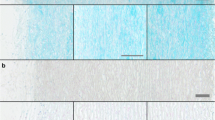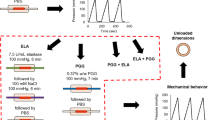Abstract
The heterogeneity and contribution of collagen and elastin to residual stresses have been thoroughly studied, but more recently, glycosaminoglycans (GAGs) also emerged as potential regulators. In this study, the opening angle of aortic rings (an indicator of circumferential residual stresses) and the mural distributions of sulfated GAGs (sGAG), collagen, and elastin were quantified in the ascending, aortic arch and descending thoracic regions of 5- to 6-month-old pigs. The opening angle correlated positively with the aortic ring’s mean radius and thickness, with good and moderate correlations respectively. The correlations between the sGAG, collagen, elastin, and collagen:sGAG ratio and the opening angle were evaluated to identify aortic compositional factors that could play roles in regulating circumferential residual stresses. The total collagen:sGAG ratio displayed the strongest correlation with the opening angle (r = − 0.715, p < 0.001), followed by the total sGAG content which demonstrated a good correlation (r = 0.623, p < 0.001). Additionally, the intramural gradients of collagen, sGAG and collagen:sGAG correlated moderately with the opening angle. We propose that, in addition to the individual role sGAG play through their content and intramural gradient, the interaction between collagen and sGAG should be considered when evaluating circumferential residual stresses in the aorta.






Similar content being viewed by others
Change history
26 January 2022
The original article was revised to correct the editorial responsibility line
References
Alastrué, V., E. Peña, M. Á. Martínez, and M. Doblaré. Assessing the use of the “opening angle method” to enforce residual stresses in patient-specific arteries. Ann. Biomed. Eng. 35:1821–1837, 2007.
Amabili, M., P. Balasubramanian, I. Bozzo, I. D. Breslavsky, and G. Ferrari. Layer-specific hyperelastic and viscoelastic characterization of human descending thoracic aortas. J. Mech. Behav. Biomed. Mater. 99:27–46, 2019.
Azeloglu, E. U., M. B. Albro, V. A. Thimmappa, G. A. Ateshian, and K. D. Costa. Heterogeneous transmural proteoglycan distribution provides a mechanism for regulating residual stresses in the aorta. Am. J. Physiol. Heart Circ. Physiol. 294:H1197–H1205, 2008.
Beenakker, J.-W.M., B. A. Ashcroft, J. H. N. Lindeman, and T. H. Oosterkamp. Mechanical properties of the extracellular matrix of the aorta studied by enzymatic treatments. Biophys. J. 102:1731–1737, 2012.
Bellini, C., J. Ferruzzi, S. Roccabianca, E. S. Di Martino, and J. D. Humphrey. A microstructurally motivated model of arterial wall mechanics with mechanobiological implications. Ann. Biomed. Eng. 42:488–502, 2014.
Camplejohn, K. L., and S. A. Allard. Limitations of safranin ‘O’ staining in proteoglycan-depleted cartilage demonstrated with monoclonal antibodies. Histochemistry. 89:185–188, 1988.
Cardamone, L., A. Valentín, J. F. Eberth, and J. D. Humphrey. Origin of axial prestretch and residual stress in arteries. Biomech. Model. Mechanobiol. 8:431, 2009.
Davis, E. C. Elastic lamina growth in the developing mouse aorta. J. Histochem. Cytochem. 43:1115–1123, 1995.
Díaz, C., J. A. Peña, M. A. Martínez, and E. Peña. Unraveling the multilayer mechanical response of aorta using layer-specific residual stresses and experimental properties. J. Mech. Behav. Biomed. Mater. 113:104070, 2021.
Fonck, E., G. Prod’hom, S. Roy, L. Augsburger, D. A. Rüfenacht, and N. Stergiopulos. Effect of elastin degradation on carotid wall mechanics as assessed by a constituent-based biomechanical model. Am. J. Physiol. Heart Circ. Physiol. 292:H2754–H2763, 2007.
Ghadie, N., J.-P. St-Pierre, and M. R. Labrosse. Intramural glycosaminoglycans distribution vs. residual stress in porcine ascending aorta: a computational study. Annu. Int. Conf. IEEE Eng. Med. Biol. Soc., 2020. https://doi.org/10.1109/EMBC44109.2020.9176381
Ghadie, N., J.-P. St-Pierre, and M. Labrosse. The contribution of glycosaminoglycans/proteoglycans to aortic mechanics in health and disease: a critical review. IEEE Trans. Biomed. Eng. 2021. https://doi.org/10.1109/TBME.2021.3074053.
Greenwald, S. E., J. E. Moore Jr., A. Rachev, T. P. C. Kane, and J.-J. Meister. Experimental investigation of the distribution of residual strains in the artery wall. J. Biomech. Eng. 119:438–444, 1997.
Guo, X., Y. Lanir, and G. S. Kassab. Effect of osmolarity on the zero-stress state and mechanical properties of aorta. Am. J. Physiol. Heart Circ. Physiol. 293:H2328–H2334, 2007.
Hazra, A., and N. Gogtay. Biostatistics series module 6: correlation and linear regression. Indian J. Dermatol. 61:593, 2016.
Hillman, H. Limitations of clinical and biological histology. Med. Hypotheses. 54:553–564, 2000.
Holzapfel, G. A., T. C. Gasser, and R. W. Ogden. A new constitutive framework for arterial wall mechanics and a comparative study of material models. In: Cardiovascular Soft Tissue Mechanics, edited by S. C. Cowin, and J. D. Humphrey. Dordrecht: Kluwer Academic Publishers, 2004, pp. 1–48.
Holzapfel, G. A., and R. W. Ogden. Modelling the layer-specific three-dimensional residual stresses in arteries, with an application to the human aorta. J. R. Soc. Interface. 7:787–799, 2010.
Holzapfel, G. A., G. Sommer, M. Auer, P. Regitnig, and R. W. Ogden. Layer-specific 3D residual deformations of human aortas with non-atherosclerotic intimal thickening. Ann. Biomed. Eng. 35:530–545, 2007.
Humphrey, J. D. Cardiovascular Solid Mechanics: Cells, Tissues, and Organs. New York: Springer, 2002.
Humphrey, J. D., and K. R. Rajagopal. A constrained mixture model for growth and remodeling of soft tissues. Math. Models Methods Appl. Sci. 12:407–430, 2002.
Jadidi, M., S. A. Razian, M. Habibnezhad, E. Anttila, and A. Kamenskiy. Mechanical, structural, and physiologic differences in human elastic and muscular arteries of different ages: comparison of the descending thoracic aorta to the superficial femoral artery. Acta Biomaterialia. 119:268–283, 2021.
Kesava Reddy, G., and C. S. Enwemeka. A simplified method for the analysis of hydroxyproline in biological tissues. Clin. Biochem. 29:225–229, 1996.
Labrosse, M. R., E. R. Gerson, J. P. Veinot, and C. J. Beller. Mechanical characterization of human aortas from pressurization testing and a paradigm shift for circumferential residual stress. J. Mech. Behav. Biomed. Mater. 17:44–55, 2013.
Lai, W. M., J. S. Hou, and V. C. Mow. A triphasic theory for the swelling and deformation behaviors of articular cartilage. J. Biomech. Eng. 113:245–258, 1991.
Lanir, Y. Mechanisms of residual stress in soft tissues. J. Biomech. Eng. 131:044506, 2009.
Lanir, Y. Osmotic swelling and residual stress in cardiovascular tissues. J. Biomech. 45:780–789, 2012.
Maes, L., H. Fehervary, J. Vastmans, S. J. Mousavi, S. Avril, and N. Famaey. Constrained mixture modeling affects material parameter identification from planar biaxial tests. J. Mech. Behav. Biomed. Mater. 95:124–135, 2019.
Martufi, G., and T. C. Gasser. A constitutive model for vascular tissue that integrates fibril, fiber and continuum levels with application to the isotropic and passive properties of the infrarenal aorta. J. Biomech. 44:2544–2550, 2011.
Matsumoto, T., M. Tsuchida, and M. Sato. Change in intramural strain distribution in rat aorta due to smooth muscle contraction and relaxation. Am. J. Physiol. Heart Circ. Physiol. 271:H1711–H1716, 1996.
Mattson, J. M., R. Turcotte, and Y. Zhang. Glycosaminoglycans contribute to extracellular matrix fiber recruitment and arterial wall mechanics. Biomech. Model. Mechanobiol. 16:213–225, 2017.
Mousavi, S. J., and S. Avril. Patient-specific stress analyses in the ascending thoracic aorta using a finite-element implementation of the constrained mixture theory. Biomech. Model. Mechanobiol. 16:1765–1777, 2017.
Panpho, P., B. Geraghty, Y. H. Chim, H. A. Davies, M. L. Field, J. Madine, and R. Akhtar. Macro- and micro-mechanical properties of the ovine aorta: correlation with regional variations in collagen, elastin and glycosaminoglycan levels. ARTRES. 25:27, 2019.
Peña, J. A., M. A. Martínez, and E. Peña. Layer-specific residual deformations and uniaxial and biaxial mechanical properties of thoracic porcine aorta. J. Mech. Behav. Biomed. Mater. 50:55–69, 2015.
Rachev, A., and T. Shazly. A structure-based constitutive model of arterial tissue considering individual natural configurations of elastin and collagen. J. Mech. Behav. Biomed. Mater. 90:61–72, 2019.
Safi, H. J., C. C. Miller, C. Carr, D. C. Iliopoulos, D. A. Dorsay, and J. C. Baldwin. Importance of intercostal artery reattachment during thoracoabdominal aortic aneurysm repair. J. Vasc. Surg. 27:58–68, 1998.
Saini, A., C. Berry, and S. Greenwald. Effect of age and sex on residual stress in the aorta. JVR. 32:398–405, 1995.
Sassani, S. G., S. Tsangaris, and D. P. Sokolis. Layer- and region-specific material characterization of ascending thoracic aortic aneurysms by microstructure-based models. J. Biomech. 48:3757–3765, 2015.
Scott, J. E. Elasticity in extracellular matrix ‘shape modules’ of tendon, cartilage, etc. A sliding proteoglycan-filament model. J. Physiol. 553:335–343, 2003.
Sigaeva, T., G. Sommer, G. A. Holzapfel, and E. S. Di Martino. Anisotropic residual stresses in arteries. J. R. Soc. Interface. 16:20190029, 2019.
Sokolis, D. P. Regional distribution of layer-specific circumferential residual deformations and opening angles in the porcine aorta. J. Biomech. 96:109335, 2019.
Sommer, G., P. Regitnig, L. Költringer, and G. A. Holzapfel. Biaxial mechanical properties of intact and layer-dissected human carotid arteries at physiological and supraphysiological loadings. Am. J. Physiol. Heart Circ. Physiol. 298:H898–H912, 2010.
Volokh, K. Y. Compressibility of arterial wall in ring-cutting experiments. 8, 2006.
Wagenseil, J. E., and R. P. Mecham. Vascular extracellular matrix and arterial mechanics. Physiol. Rev. 89:957–989, 2009.
Zeinali-Davarani, S., M.-J. Chow, R. Turcotte, and Y. Zhang. Characterization of biaxial mechanical behavior of porcine aorta under gradual elastin degradation. Ann. Biomed. Eng. 41:1528–1538, 2013.
Zeller, P. J., and T. C. Skalak. contribution of individual structural components in determining the zero-stress state in small arteries. J. Vasc. Res. 35:8–17, 1998.
Zheng, C., and M. E. Levenston. Fact versus artifact: avoiding erroneous estimates of sulfated glycosaminoglycan content using the dimethylmethylene blue colorimetric assay for tissue-engineered constructs. Eur. Cell Mater. 29:224–236, 2015.
Acknowledgments
The authors would like to thank Dr. Xudong Cao for the use of some of his equipment. This work was supported by the Natural Sciences and Engineering Research Council of Canada (JPS: RGPIN-2017-04593, 2017-2022; MRL: RGPIN-2017-04588, 2017-2022). Instruments used in the study were acquired with funds from the Canadian Foundation for Innovation (JPS: CFI-37732; 2020-2022) with matching funds from the Ministry of Economic Development, Job Creation and Trade Ontario Research Fund.
Conflict of interest
The authors report no conflict of interest.
Author information
Authors and Affiliations
Corresponding author
Additional information
Associate Editor Elisabetta Zanetti oversaw the review of this article.
Publisher's Note
Springer Nature remains neutral with regard to jurisdictional claims in published maps and institutional affiliations.
Supplementary Information
Below is the link to the electronic supplementary material.
Rights and permissions
About this article
Cite this article
Ghadie, N.M., St-Pierre, JP. & Labrosse, M.R. Intramural Distributions of GAGs and Collagen vs. Opening Angle of the Intact Porcine Aortic Wall. Ann Biomed Eng 50, 157–168 (2022). https://doi.org/10.1007/s10439-022-02901-8
Received:
Accepted:
Published:
Issue Date:
DOI: https://doi.org/10.1007/s10439-022-02901-8




